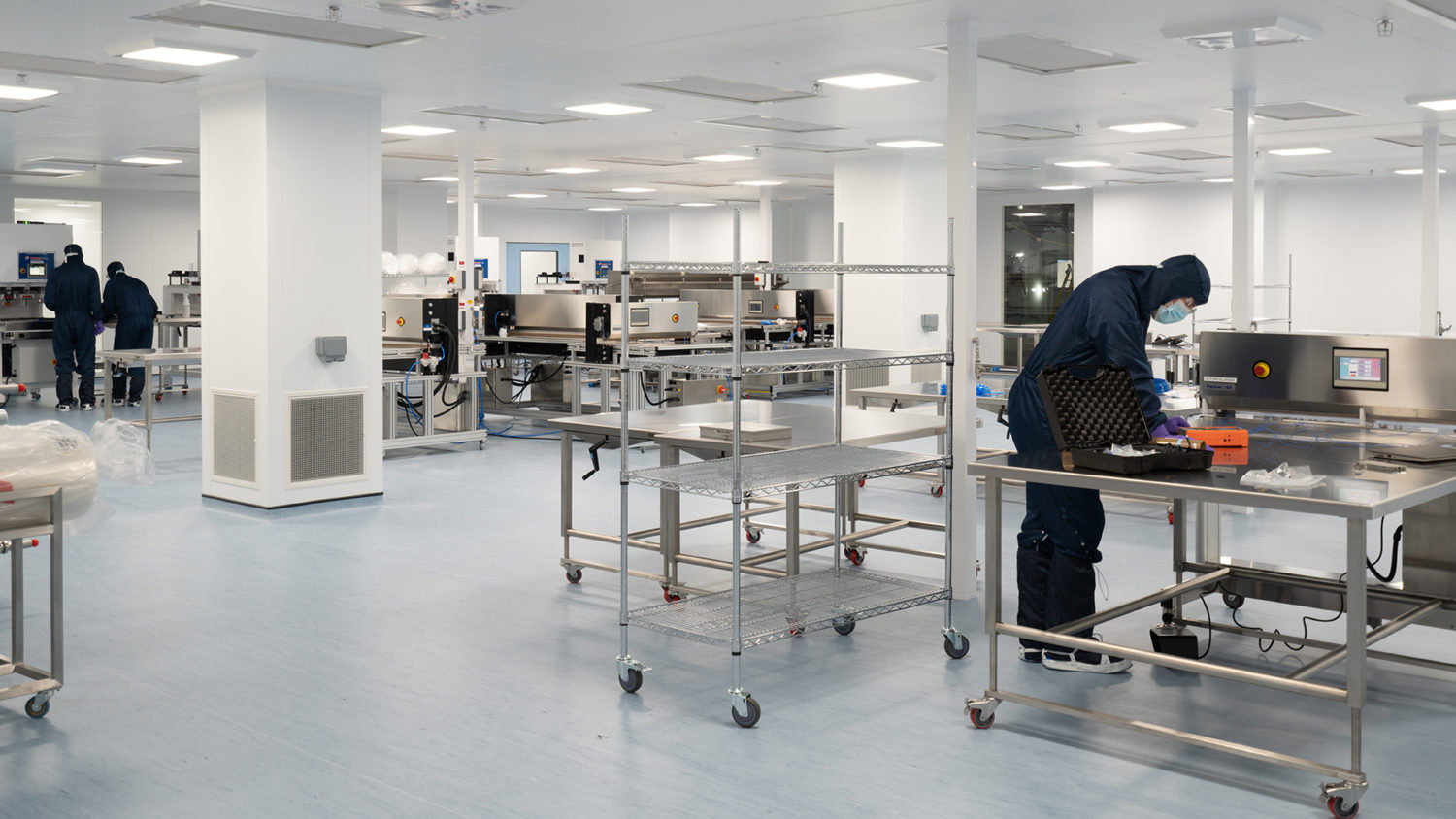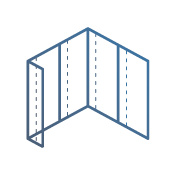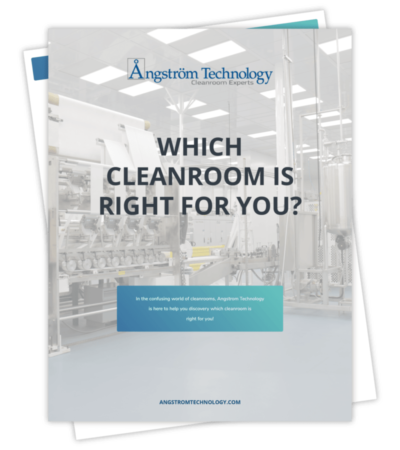Classification Standards
Tailored Cleanroom Solutions for All Classification Standards
Angstrom Technology designs, builds, and installs cleanrooms that meet classification standards, as well as industry-specific requirements. Hardwall, Softwall, and Rigidwall wall systems are used to construct modular cleanroom environments that are easily customized to your unique application. Our cleanrooms can be modified, expanded, condensed, or relocated as your project needs evolve.
Our cleanroom experts work with you to design the ideal layout, airflow pattern, and level of control needed to reach your cleanroom classification and always keep your facility in peak performance and efficiency. To get started developing your modular cleanroom, give Angstrom Technology a call!
What Are Cleanroom Classifications?
Cleanroom classifications are an important factor in a cleanroom’s design, development, and use. They determine a cleanroom’s degree of cleanliness and are defined by the allowed amount of contamination by particle count and size, as well as the necessary air change rates depending on the cleanroom’s classification level.
There are a variety of classifications that govern cleanroom cleanliness, but the main system is laid out by the International Standards Organization. ISO classifications apply to all cleanroom industries and applications. Other standards and regulations, such as the USP or ASTM International Standards, are organized around industry-specific requirements. Let’s breakdown cleanroom classifications in more detail.
Types of Cleanroom Classifications
Cleanroom classifications exist to regulate contaminants and control product quality. All cleanrooms fall within the overarching classification system, ISO 14644-1, developed by the International Standards Organization. Each industry may have its own additional requirements to control the cleanroom environment and protect products, processes, and employees. For instance, other cleanroom ISO standards — such as ISO 13485 for medical device cleanrooms or ISO 14698 for cleanroom biocontamination control — were developed to prioritize threats those specific applications usually face.
ISO Cleanroom Classifications
The International Standards Organization’s classification system became the official system in 2001. ISO 14644-1 categorizes cleanrooms into Classes 1-9.
Federal 209E Standards
Federal 209E Standards were replaced by ISO Classes in 2001. The Federal Standards used to categorize cleanrooms into Classes 1-100,000.
Other Cleanroom Standards
Some cleanroom applications must comply with special standards, such as cGMP, that are uniquely tailored to the threats facing their products and processes.
ISO Cleanroom Classifications
The classification system within ISO 14644-1 became the official system in 2001, replacing the Federal 209E Standards. The new system broadened the scope of classifications to include more types of cleanrooms, adding two stricter classes and one less strict. The ISO 14644-1 classifications are divided into Classes 1-9, whereas the Federal 209E Standards described Classes 1-100,000 (or ISO Classes 3-8).
ISO Equivalent for Federal Standard Classes
| ISO CLASS | FEDERAL 209E STANDARD |
| ISO 1 | N/A |
| ISO 2 | N/A |
| ISO 3 | CLASS 1 |
| ISO 4 | CLASS 10 |
| ISO 5 | CLASS 100 |
| ISO 6 | CLASS 1,000 |
| ISO 7 | CLASS 10,000 |
| ISO 8 | CLASS 100,000 |
| ISO 9 | N/A ROOM AIR |
ISO 14644-1 Cleanroom Classifications
ISO 14644-1 requirements describe contamination levels in terms of allowed air particulates in number and size, determine the air change rates or airflow speed within the cleanroom, and outline the necessary percentage of ceiling coverage for filtration. Classes in ISO 14644-1 are divided from 1 to 9, where Class 9 is equivalent to room air and Class 1 represents the cleanest possible cleanroom environment. As the classification number falls, cleanrooms rapidly become cleaner and must comply with stricter standards. The majority of cleanrooms fall within ISO Classes 7-8. ISO 5 is considered to be the dividing line where cleanrooms become heavily restricted by rigorous requirements for filtration, contamination, and environmental control.
ISO 14644-1 Cleanroom Standards
| Class | Maximum Allowed Particles (per m3) | Air Change Rate (per hour) | Airflow Velocity (ft/min) | Ceiling Coverage | ||||
| ≥0.2 µm | ≥0.3 µm | ≥0.5 µm | ≥1 µm | ≥5 µm | ||||
| ISO 1 | 2.37 | 1.02 | 0.35 | 0.083 | 0.0029 | 360-600 | 60-100 | 90-100% |
| ISO 2 | 23.7 | 10.2 | 3.5 | 0.83 | 0.029 | 360-600 | 60-100 | 80-100% |
| ISO 3 | 237 | 102 | 35 | 8.3 | 0.29 | 360-540 | 60-90 | 60-100% |
| ISO 4 | 2,370 | 1,020 | 352 | 83 | 2.9 | 300-540 | 50-90 | 50-90% |
| ISO 5 | 23,700 | 10,200 | 3,520 | 832 | 29 | 240-480 | 40-80 | 35-70% |
| ISO 6 | 237,000 | 102,000 | 35,200 | 8,320 | 293 | 150-240 | 25-40 | 25-40% |
| ISO 7 | 2.37×106 | 1,020,000 | 352,000 | 83,200 | 2,930 | 60-90 | 10-15 | 15-20% |
| ISO 8 | 2.37×107 | 1.02×107 | 3,520,000 | 832,000 | 29,300 | 5-48 | 1-8 | 5-15% |
| ISO 9 | 2.37×108 | 1.02×108 | 35,200,000 | 8,320,000 | 293,000 | 0-25 | 0-5 | 5-10% |
As you can see, classes are organized by three major factors: particle size and count, air change rates or airflow velocity, and percentage of ceiling coverage. Of these three factors, particle count and air change rates are the most important.
Particle Count
Particle count in each class is measured based on particles of a certain size per cubic meter. As the class number decreases and requirements become more strict, the allowed number particles is reduced, as well as the size of those particles. You can see, for example, the difference between particle count and size allowed in Class 7 cleanrooms (352,000 at 0.5 per cubic meter) versus a Class 5 cleanroom (only 3,520 at 0.5 per cubic meter).
Particle size is measured in microns (µm) per cubic meter. In stricter classes, even the tiniest particles can interfere with and contaminate products and operations within a controlled cleanroom environment. As the classification becomes more stringent, smaller particles must be filtered out using specialized filters. Cleanrooms use a specially designed airflow pattern that makes use of filters in the most efficient and effective way possible to trap and remove particles, and replace the air in the room with air that is fresh and contaminant-free. The rate at which this process completely changes and replaces the room’s air is called the air change rate.
Air Change Rates
In ISO Classes 4-9, air change rates are expressed as the rate per hour the air in the cleanroom is completely refreshed (ACH = air changes per hour). As cleanroom classifications become more stringent, the air change rate must increase to remove particles and keep the air cleaner. In Class 5 and below, the strictest cleanroom classifications, the air change rate is so rapid it is expressed instead as airflow velocity, either in meters per second or feet per minute. These cleanroom environments require air that is extremely clean, so the constant changing of contaminant-free air is vital to maintain classification standards.
When upgrading to a stricter cleanroom classification, an important step is to increase the filtration and air change rate to remove more particles of a smaller size from the air. For example, ISO Class 7 requires between 60-90 ACH and allows for 352,000 particles at 0.5 microns per cubic meter. To move to an ISO Class 6, the facility would need to increase to 150-240 ACH to filter all but 35,200 particles at 0.5 microns per cubic meter. The more stringent the classification, the more extreme the standards of cleanliness. Extremely clean cleanrooms require extensive filtration and powerful HVAC systems to maintain classification standards.
Ceiling Coverage
Ceiling coverage refers to the percentage of ceiling coverage for HEPA filter/fan units, or FFUs. Ceiling fan coverage is closely related to air change rate, as more FFUs will allow for more air changes to occur. FFUs require a lot of energy to run, so the smallest coverage percentage to maintain sufficient cleanliness is recommended for efficiency.
It’s important to note that cleanrooms in ISO Class 5 and lower also measure cleanliness at different stages, specifically “in operation,” and “at rest.” These stages are defined because cleanrooms with extremely stringent requirements have different certification levels depending on the cleanroom’s stage. A room “at rest” means that all of the equipment, furniture, etc. is in the cleanroom, but no people or processes are working or running. “In operation,” on the other hand, means that all people and machinery are running at full production. It will understandably take less HEPA filtration and ACH to achieve certification “at rest,” as opposed to “in operation,” because there is less activity in the room and fewer contaminants being shed or transferred.
ISO 14644-2 Cleanroom Classification Monitoring
ISO 14644-2 describes the practices for testing and monitoring cleanrooms to ensure they comply with classification standards. All cleanrooms require periodic testing to make sure they reach the necessary particle count allowances and are effectively maintaining a clean environment. Cleanrooms with more stringent standards (ISO Class 5 and lower) must commit to particle count tests every 6 months. All other cleanrooms must complete yearly tests. All cleanrooms must also test airflow and air pressure differentials annually.

Cleanroom Standards
Some cleanroom applications must comply with special standards that are uniquely tailored to the threats facing their products and processes. Additional standards or industry requirements provide an extra level of protection, limiting allowed contaminants within controlled cleanroom spaces or specifying cleanroom layouts, safe operating practices, or cleaning procedures. These standards work to protect the products developed in cleanrooms and the people working to create them. A few examples of additional cleanroom standards are USP, ASTM and GMP.
Federal 209E Standards
USP Standards
US Pharmacopeia (USP) has a set of standards used to regulate cleanrooms developing, manufacturing, and packaging pharmaceutical products either for use in human or animal treatments. Most pharmaceutical cleanrooms must abide by USP 795, 797, or 800 standards.
- USP 795: non-sterile pharmaceutical compounds
- USP 797: sterile non-hazardous compounds
- USP 800: sterile hazardous compounds
USP Standards exist to ensure product strength, quality, and purity so that all compounds are certified to be high quality, safe to use, and effective as a treatment or therapy.
ASTM International Standards
American Society for Testing and Materials International (ASTM) develops technical standards for many different industries from manufacturing to consumer product safety, some of which use cleanrooms to develop, test, manufacture, or package products. Three major cleanroom applications that subscribe to ASTM standards are automotive cleanrooms, aerospace cleanrooms, and plastics manufacturing cleanrooms.
ASTM standards are used to regulate a number of products, substances, and processes, including metal, rubber, construction materials, petroleum, textiles, solar technology, medical products and devices, nanotechnology, additive manufacturing, and industrial biotechnology, to name just a few examples.
GMP & CGMP Regulations
Good Manufacturing Practice, or GMP, regulations ensure product consistency and quality, specifically when applied to food, drugs, medical devices and products, and also blood. GMP covers topics from materials used in handling and production to employee training, facility requirements, and hygiene practices. The purpose of GMP regulations is to make sure all products are effective, pure, safe, and free of contamination. Products that are certified GMP promise high quality and safety throughout their lifetime.
GMP regulations are outlined by the US Food and Drug Administration and are backed by the power of FDA laws. They are particularly important in medical cleanrooms, including medical research, pharmaceutical cleanrooms, and medical device manufacturing, but also for food production and biosafe cleanrooms.
CGMP, or current Good Manufacturing Practices, refers to the current, up-to-date practices businesses must follow. GMP regulations are often revised and it is the responsibility of the business to make sure its facilities and staff are updated accordingly.
Designing For Cleanroom Classifications
As we’ve examined, cleanroom classifications are mainly determined through the management of particle count and size, air change rates or airflow velocities, and ceiling coverage for filtration. To design a cleanroom to meet a cleanroom classification, special considerations must be made to account for the differences in these three areas. The major components of cleanroom design include cleanroom filtration, airflow patterns, pressurization, HVAC, and other cleanroom supplies and materials.
Cleanroom Filtration
Depending on your cleanroom classification, you are required to filter out a certain number of particles of a specific size. To provide consistent and contaminant-free air, particles are removed using HEPA or ULPA filters, depending on target particle size:
- HEPA filters, or High-Efficiency Particulate Air filters, are used to remove 99.99% of particles 0.3µm or larger in diameter.
- ULPA filters, or Ultra Low Particulate Air filters, function similarly to HEPA filters, but are rated to remove 99.999% of all contaminants larger than 0.12µm.
Most cleanrooms utilize multi-stage filtration to extend the life of expensive HEPA filters and trap contaminants more effectively and efficiently. To do this, pre-filters are placed before HEPA or ULPA filters to draw out larger particles. Prefilters are generally replaced every other month, while HEPA and ULPA filters can last up to 7 years.
Fan filter units (FFUs) push out clean, filtered air into the cleanroom space. The frequency of these units makes up the cleanroom’s ceiling coverage. Optimal ceiling coverage depends on the size of the cleanroom and the desired level of filtration or cleanliness. A good equation for calculating ceiling coverage, or necessary number of FFUs, is to take your cleanroom’s ACH divided by 60, and multiply it by the cubic footage of the room, divided by 650 (the CFM output of a FFU). In mathematical form, this looks like: FFUs = (ACH / 60) x (ft3 / 650).
Airflow Patterns
Airflow patterns are critical to ensure and consistent flow of clean air and assist filters in doing their job effectively. Most cleanrooms use laminar airflow. This pattern pushes clean air in one direction through the space to limit particles and contaminants from settling or accumulating in one spot.
Your cleanroom layout should allow the air to flow according to its pattern without creating any spaces where contaminants could build up or block filters. During cleanroom design, computational fluid dynamics software can be used to model airflow patterns to determine the optimal placement of FFUs, cleanroom walls, and even equipment and cleanroom furniture.
Cleanroom Pressurization
Another important cleanroom design feature is cleanroom pressurization. Pressure within the cleanroom is determined by the amount and direction of air flowing in and out of the cleanroom environment. Most cleanrooms use positive pressure, which means more air is filtered into the space than removed. Positive pressure prevents air from leaking around doors, seams, or any crevices and into the cleanroom environment where it could cause contamination.
Some cleanrooms, particularly those working with hazardous or infectious substances, use negative pressure. In negative pressure cleanrooms, more air is filtered out than is brought into the cleanroom in order to prevent contaminants inside the cleanroom from escaping.
HVAC Environmental Control
In all cleanroom design, a controlled environment is a safe environment. A big part of environmental control is managed by your cleanroom’s HVAC system. The HVAC system controls the temperature, humidity, and circulation of air within the cleanroom.
The HVAC system creates an environment that is not only comfortable for employees to work, but also protected from the dangers of moisture, humidity, and fluctuations in temperature to maintain a stable atmosphere for all products and processes. Depending on the finite level of control required by your cleanroom classification, you may need a powerful HVAC system to adjust your environment to your project’s specifications.
Cleanroom Supplies & Materials
Cleanroom design doesn’t stop at the essential systems like filtration and HVAC. Your cleanroom classification also extends to industry-specific equipment, cleanroom furniture, and the materials used in cleanroom construction. If you’re building your cleanroom around existing structures or mounted equipment, you may need to adjust your layout and filter placement to prevent the buildup of contaminants in the space.
The specific materials and furniture themselves must also be safe for cleanroom use, as required by your cleanroom classification. Different ISO classes and other standards have different requirements for materials in order to protect products and limit possible contamination. For example, some applications require the use of ESD-safe (electro-static discharge) materials to protect employees and products from contamination or charges resulting from static electricity.
Cleanroom Classifications by Industry & Application
Designing a cleanroom for different applications requires careful attention to your cleanroom classification. Some industries require more control over the cleanroom environment and are regulated by stringent requirements, particularly in medical applications or processes that involve fine electronics. Let’s look at typical cleanroom classifications and special standards associated with a few major industries.
Aerospace Cleanrooms
Per ASTM E2352, aerospace cleanrooms must meet International Organization of Standards (ISO) 14644-1, starting from a minimum ISO Class 7/Federal Standard 209 Class 10,000 requirement. More extreme standards apply for highly sensitive applications, where airborne particle concentrations must be strictly controlled such as in the development of spacecraft hardware, fine electronics, or optical devices.
Medical Cleanrooms
Medical research laboratories require strict cleanroom conditions, and usually fall within ISO Class 5-7. The rigorousness of the standard is dictated by the risk level of contaminants to cleanroom operations and safety.
The minimum standard for pharmaceutical cleanrooms is generally ISO 5 (Federal Standard 209 Class 100), which requires 240-600 air changes per hour and 35-70 percent ceiling coverage to maintain an environment of 100,000 0.1μm particles per cubic meter. Pharmaceutical cleanrooms are also governed by additional regulations by US Pharmacopeia, or USP Standards.
Medical device production, assembly, and packaging have different cleanliness requirements, and often fall under separate classifications. Most medical device manufacturing cleanrooms must comply with ISO 5-8 standards, per ISO 14644-1, while medical device packaging requires ISO 7-8. All medical device cleanrooms must also comply with ISO 13485:2016 which designates a quality management system to ensure product quality and assess risk throughout the device’s lifetime.
Plastics Cleanrooms
Plastics cleanrooms typically fall within an ISO 14644-1 Class 7-8, but are also managed by ASTM Standards. Depending on the types of plastics being used and the application of the products, more safeguards will need to be in place to limit contamination. For example, plastic used in packaging of medical devices will require more aseptic control than plastic manufactured for building products.
Plastics cleanrooms are also sensitive to static electricity. Similar to medical device and aerospace cleanrooms, ESD-safe materials should be used to protect products and employees within the cleanroom environment.
Automotive Cleanrooms
Automotive cleanrooms typically fall within ISO 14644-1 Class 7-8. Many applications of manufacturing for automotive parts and processes require strict control over temperature, humidity and pressure. From drying paint to assembling fine electrical components, a sterile environment is critical to ensuring product effectiveness and safety on the road.
Automotive cleanrooms are subject to regulations by ASTM to ensure product durability and consumer safety. ASTM standards exist for nearly every component of automotive manufacturing and assembly, from standards for steel production, to fasteners and paint, to airbag safety ratings.
Cleanroom Classification Services
Angstrom Technology’s cleanroom experts provide the best modular cleanrooms on the market in all phases of creation, development, and installation. From the initial design to construction, to adaptation and reconfiguration, to routine maintenance and cleaning, Angstrom Technology makes sure your space meets all cleanroom classifications and industry requirements so you can focus on developing, creating, and exploring.

Softwall Cleanrooms
Softwall cleanrooms are a minimalist, lightweight cleanroom type that can accommodate most classifications standards, and are ideally suited for ISO Classes 4-8. Their extremely flexible design makes them great for applications that need room to grow. Softwall cleanrooms can fit in almost any space and are fully customizable with a wide variety of filtration options, door types, and more. They are an affordable option that’s easy to assemble and maintain.

Hardwall Cleanrooms
For cleanrooms with rigorous classification standards, we offer Hardwall cleanrooms. Hardwall cleanrooms are designed to comply with the most stringent cleanroom classifications and can be freestanding or incorporated into your existing building. Made using a coated aluminum frame with a prefabricated panel, Hardwall modular cleanroom panels are designed to achieve a high level of control over static, pressure, humidity, and contamination.

Rigidwall Cleanrooms
Our Rigidwall cleanrooms can also provide a suitable environment for applications ISO Class 5-8, while offering a greater degree of versatility, allowing you to make changes as necessary to the layout of your cleanroom. Using your choice of acrylic, static dissipative PVC, or polycarbonate wall panels, your Rigidwall cleanroom will house your operations in an effective and attractive style you can see through for monitoring purposes or showing investors.
Cleanroom Design
When it comes to cleanroom design, we base the plans in your cleanroom classification and unique application needs, consider other features that will make your work easier and more efficient, then design the ideal cleanroom for you. We can even help you decide where to install your cleanroom to work best for your facility. We use computational fluid dynamics to create a digital model of your cleanroom space to find the best airflow pattern for your cleanroom, reducing the strain on your cleanroom’s HVAC system and changing the air more effectively.
Our modular cleanroom types can accommodate any cleanroom classification. Talk with our cleanroom experts to find the best modular wall panel for your application.
Cleanroom Construction
Angstrom Technology can design and build a new freestanding modular cleanroom, adapt your site for cleanroom installation, or even retrofit the cleanroom build to attach to existing infrastructure. Our modular cleanrooms are pre-manufactured so they can be assembled quickly and efficiently when they arrive at your site.
We’ll provide straightforward instructions so you can set up your cleanroom yourself, or have our crew install it for you. We can also install industry-specific equipment so your cleanroom is up and running as soon as possible. We take care to set up our modular cleanrooms to your specifications and verify that all systems and materials comply with your cleanroom classification.
Reconfiguring or Upgrading Your Cleanroom
If you need to upgrade, downsize, or reconfigure your existing cleanroom, Angstrom Technology can help you redesign your cleanroom to fit your revised needs and cleanroom standards. Using modular panels, a cleanroom can be expanded or condensed to accommodate new equipment, additional personnel, or a new layout. Our cleanroom experts can help create an intuitive and efficient cleanroom layout, upgrade your cleanroom HVAC system, and design an airflow pattern that works with your new space.
If you need to upgrade your cleanroom to reach new standards or comply with a more stringent cleanroom classification, Angstrom Technology can help you modify your space. We have a thorough understanding of what’s needed at each class level, and can identify effective ways to improve your class rating while maintaining efficiency. This could include things like adding FFUs, upgrading your HVAC system, changing your airflow pattern, or increasing the capacity of your filtration system. We’ll make sure your cleanroom meets all requirements so you can stay focused on your goals.
Cleanroom Maintenance
Cleanrooms require consistent evaluation to make sure they meet classification standards, and that all systems perform efficiently and operate safely. In addition to routine maintenance, cleanrooms should also receive regular cleaning to reduce contaminant generation and prevent the transfer of contaminants inside the cleanroom.
If you want to make sure your space is always up to your cleanroom classification standards, Angstrom Technology can add you to our regular maintenance schedule for cleanroom HVAC service, filter replacement, deep cleaning, and more.
To discover more about Angstrom Technology’s cleanroom offerings, as well as our cleanroom design, maintenance, and installation services, get in touch with our team. We can provide you with a free cleanroom quote today!
Get Instant Access To Our Cleanroom Design Guide
The Most Comprehensive Guide for Cleanrooms and Modular Offices


